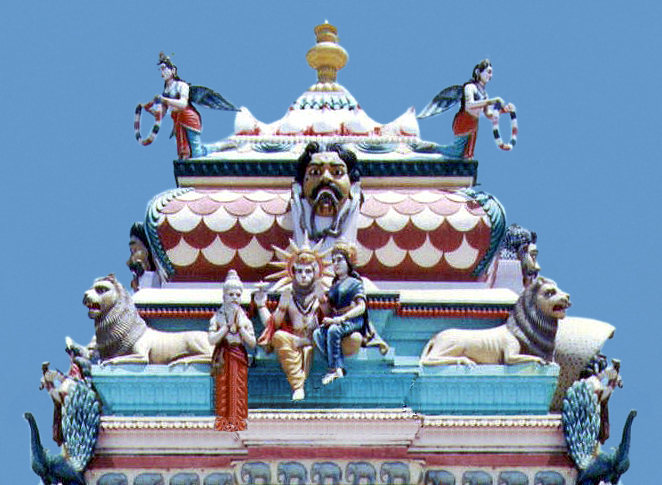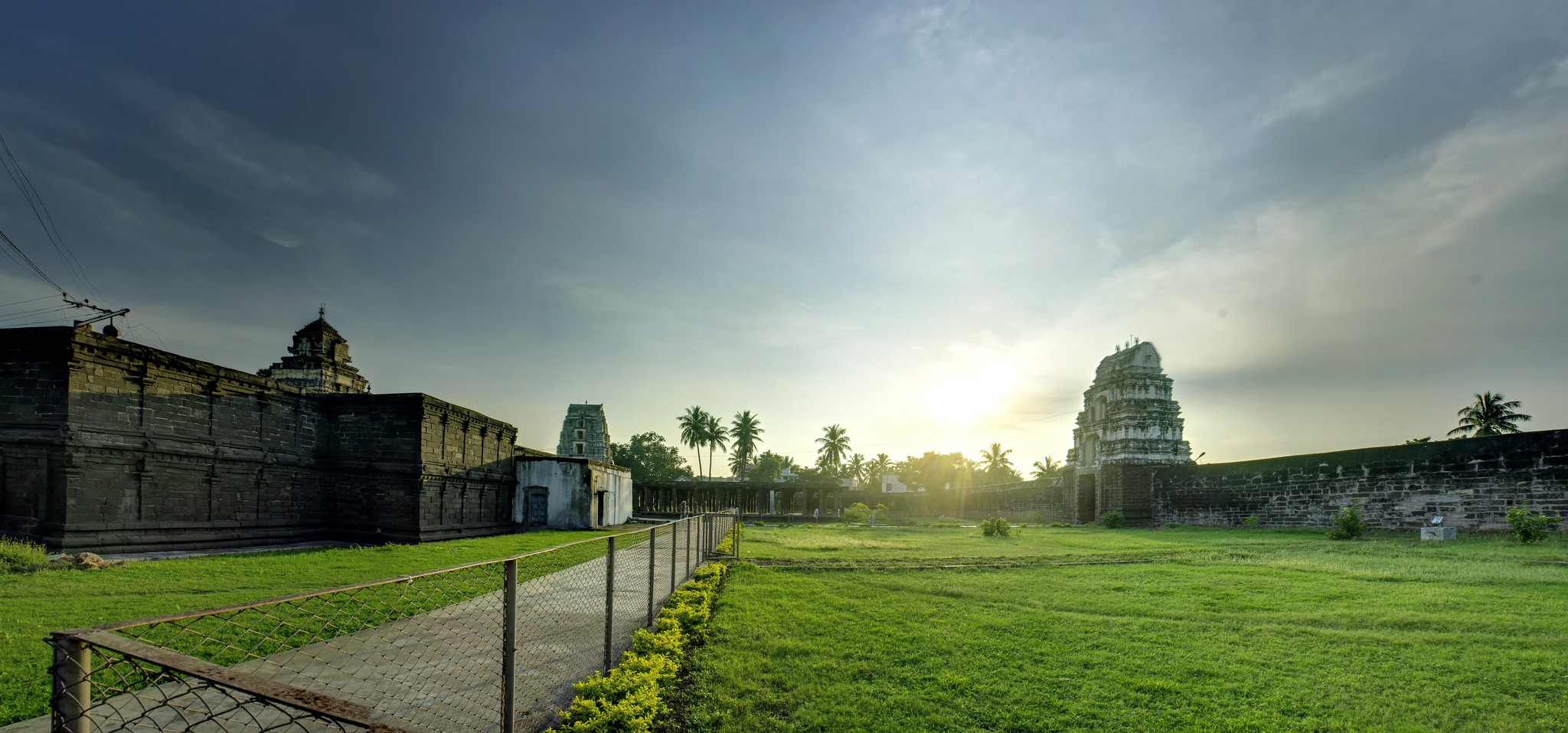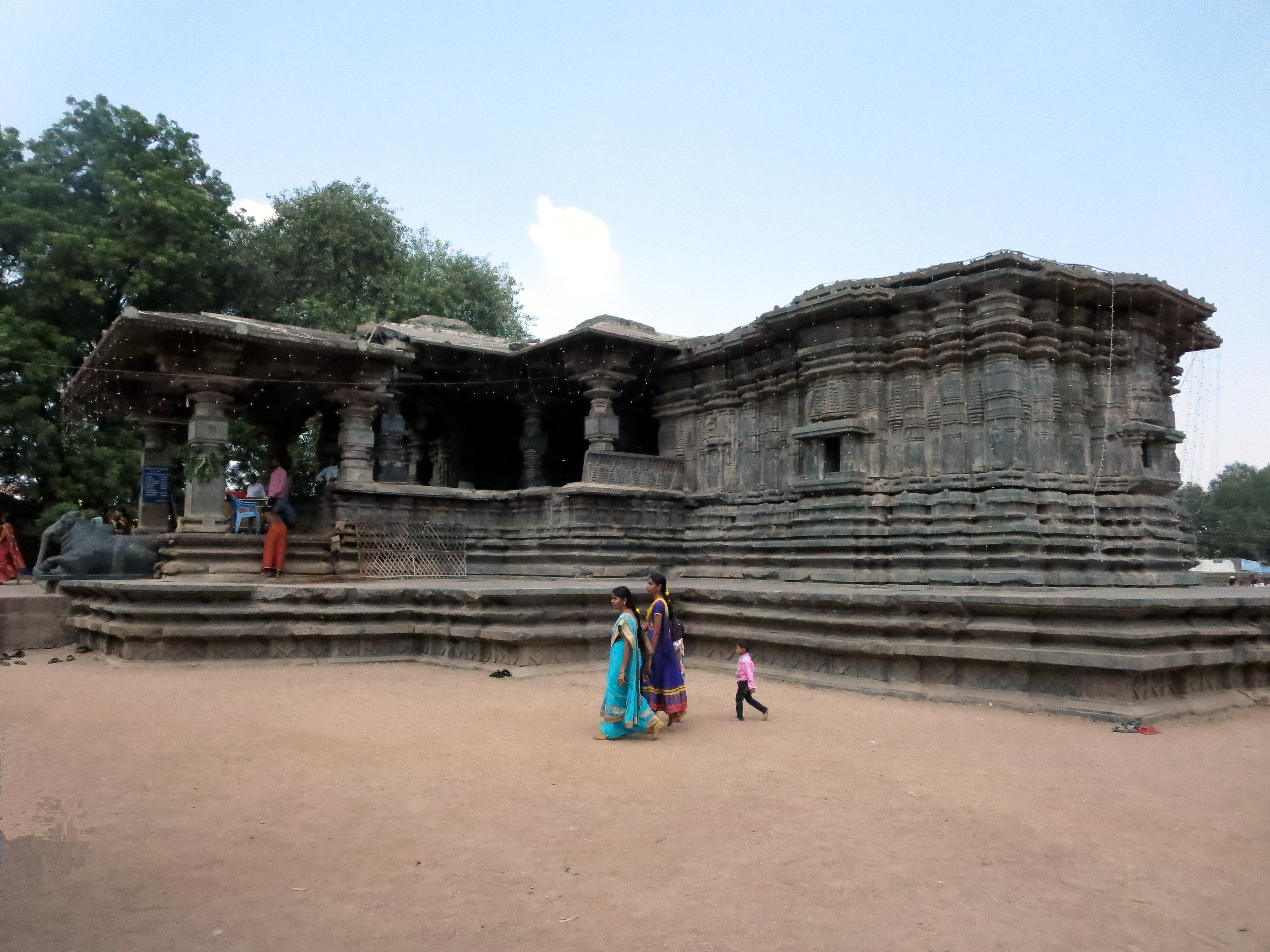|
Ganapati (Kakatiya Dynasty)
Ganapati-deva (r. c. 1199-1262) was the longest reigning monarch of the Kakatiya dynasty of southern India. He brought most of the Telugu-speaking region in present-day Andhra Pradesh and Telangana under the Kakatiya influence by war or diplomacy. Ganapati's father Mahadeva was killed in a conflict against the Seuna (Yadava) kingdom in 1198-1199, and Ganapati remained in Yadava captivity for some time. The Kakatiya commander Recherla Rudra administered the kingdom in Ganapati's name during this period, protecting it against invaders and rebels. After his release in 1199, Ganapati consolidated his rule over the kingdom, and conquered the Coastal Andhra region in a series of campaigns. He also fought with the Eastern Gangas for the control of the southern Kalinga and Vengi regions: these campaigns had mixed results, with Kakatiya control limited to the south of the Godavari River. Ganapati supported the Nellore Choda chiefs Tikka and his son Manuma-siddhi II against rival claiman ... [...More Info...] [...Related Items...] OR: [Wikipedia] [Google] [Baidu] |
Kakatiya Dynasty
The Kakatiya dynasty (IAST: Kākatīya) was an Indian dynasty that ruled most of eastern Deccan region comprising present day Telangana and Andhra Pradesh, and parts of eastern Karnataka and southern Odisha between 12th and 14th centuries. Their capital was Orugallu, now known as Warangal. Early Kakatiya rulers served as feudatories to Rashtrakutas and Western Chalukyas for more than two centuries. They assumed sovereignty under Prataparudra I in 1163 CE by suppressing other Chalukya subordinates in the Telangana region. Ganapati Deva (r. 1199–1262) significantly expanded Kakatiya lands during the 1230s and brought under Kakatiya control the Telugu-speaking lowland delta areas around the Godavari and Krishna rivers. Ganapati Deva was succeeded by Rudrama Devi (r. 1262–1289) who is one of the few queens in Indian history. Marco Polo, who visited India around 1289–1293, made note of Rudrama Devi's rule and nature in flattering terms. She successfully repelled the attacks ... [...More Info...] [...Related Items...] OR: [Wikipedia] [Google] [Baidu] |
Jaitrapala
Jaitugi (r. c. 1191-1200), also known as Jaitrapala, was a ruler of the Seuna (Yadava) dynasty of Deccan region in India. Early life Jaitugi was the son of his predecessor Bhillama V, who overthrew the Chalukya suzerainty to become independent. The last extant record from Bhillama's reign is dated August 1191, while the earliest extant record from Jaitugi's reign is dated December 1192. The Bijapur inscription, dated 25 December 1196, states that it was issued during the sixth year of Jaitugi's reign. These evidences suggest that Jaitugi ascended the throne in late 1191. Military career Victory over the Kakatiyas During the reign of his father Bhillama, Jaitugi participated in his father's wars against the Hoysala king Ballala II, resisting the enemy's attempts to capture Kalyani and Devagiri. Bhillama ultimately suffered a defeat against the Hoysalas. Taking advantage of weakened Yadava power, the Kakatiyas had invaded the eastern part of the Yadava kingdom. All three ... [...More Info...] [...Related Items...] OR: [Wikipedia] [Google] [Baidu] |
Natavadi
Natavadi is a region in the Indian state of Andhra Pradesh. It comprises, parts of Vijayawada and Nandigama mandals in Krishna district and Madhira of Khammam district Khammam district is a district in the eastern region of the Indian state of Telangana. The city of Khammam is the district headquarters. The district shares boundaries with Suryapet, Mahabubabad, Bhadradri districts and with Eluru and NTR di .... References {{Andhra Pradesh Sub regions of Andhra Pradesh Coastal Andhra Geography of Krishna district Khammam district ... [...More Info...] [...Related Items...] OR: [Wikipedia] [Google] [Baidu] |
Kanaka Durga Temple
Kanaka Durga Temple is a Hindu Temple dedicated to Goddess Kanaka Durga. The deity in this temple is also popularly referred as ''Kanaka Durga''. The temple is located in Vijayawada, Andhra Pradesh, India on the Indrakeeladri Hills on the banks of Krishna River. Kaalika Purana, Durgaa Sapthashati and other Vedic literature have mentioned about Goddess Kanaka Durga on the Indrakeelaadri and have described the deity as Swayambhu, (self-manifested) in Triteeya Kalpa. Goddess legend Popular legend is about the triumph of Goddess Kanaka Durga also popularly known as Kanaka Mahalakshmi over the demon King Mahishasura. It is said that the growing menace of demons became unbearable for the natives. Sage Indrakila practiced severe penance, and when the goddess appeared the sage pleaded Her to reside on his head and keep vigil on the wicked demons. As per his wishes of killing the demons, Goddess Durga made Indrakila Her permanent abode. Later, She also slayed the demon king Mahisha ... [...More Info...] [...Related Items...] OR: [Wikipedia] [Google] [Baidu] |
Pithapuram
Pithapuram, historically known as Pittapore, is a town and a municipality in the Kakinada district in the Indian state of Andhra Pradesh. The town also forms a part of Godavari Urban Development Authority. The town is home to one of the eighteen Maha Sakthi Peethas, which are significant shrines and pilgrimage destinations in Shaktism. Sripada Sri Vallabha, a prominent Hindu saint of 14th century was born and lived in Pithapuram. He is considered by his devotees as one of the first complete avatars (incarnations) of the deity Dattatreya in Kali Yuga. History Pithapuram was originally called Pithikapuram. The earliest extant inscription to mention the city is the fourth century king Samudragupta's Allahabad Pillar inscription, which states that he defeated the king Mahendra of Pithikapuram. The inscriptions of the fourth and fifth century Vasishtha and Mathara dynasties also mention Pishtapura, describing it as a part of Kalinga. In the seventh century, the Chalukya king ... [...More Info...] [...Related Items...] OR: [Wikipedia] [Google] [Baidu] |
Velanadu
Velanadu is a region in the Indian state of Andhra Pradesh. It comprises the east coastal areas of the state lying between the Krishna and Penna rivers. Tenali and Repalle mandals of Guntur district Guntur district is one of the twenty six districts in the Coastal Andhra region of the Indian state of Andhra Pradesh. The administrative seat of the district is located at Guntur, the largest city of the district in terms of area and with a po ... are the most notable areas under this region. References {{Andhra Pradesh Sub regions of Andhra Pradesh Coastal Andhra Geography of Guntur district Geography of Prakasam district ... [...More Info...] [...Related Items...] OR: [Wikipedia] [Google] [Baidu] |
Velanati Chodas
Velanati Cholas were one of the Chola families who ruled over parts of the Andhra Pradesh in the 12th century. They were Vassals of Later Cholas and Western Chalukyas and ruled over the region of Kammanadu in modern Guntur district. During its peak the chiefs also ruled area of Venginadu, the land between Krishna and Godavari rivers. They belonged to the Durjaya family, so they were also called as ''Durjayas of Velanadu''. Rajendra Choda II had assumed the title " Durjayakulaprakasa ".Kakatiya Nayaks: their contribution to Dakshinapath's independence, 1300-1370 A.D.N. G. Ranga (https://books.google.com/books?ie=ISO-8859-1&id=C58sAAAAMAAJ), p. 12 History Gonka I ruled as a vassal to Kulothunga I of Later Cholas of Gangaikonda Cholapuram, and his son Mummadi Varma, viceroy of Vengi. He fought as general in the battles against Kalyani Chalukyas and also against refractory vassals, Kalinga and Chakrakuta, who joined with Kalyani Chalukyas. He assumed the title ''Chola Mula Stambh ... [...More Info...] [...Related Items...] OR: [Wikipedia] [Google] [Baidu] |
Coastal Andhra
Coastal Andhra (South costal Andhra) also known as Kostha Andhra is a region in the state of Andhra Pradesh, India. Vijayawada is the largest city in this region. It was part of Madras State before 1953 and Andhra State from 1953 to 1956. According to the 2011 census, it has an area of which is 57.99% of the total state area and a population of 34,193,868 which is 69.20% of Andhra Pradesh state population. This area includes the coastal districts of Andhra Pradesh on the Circar Coast between the Eastern Ghats and the Bay of Bengal, from the northern border with Odisha to Tirupati district in the South. Coastal Andhra has rich agricultural land, owing to the delta of the Godavari Krishna river and Penna. The prosperity of Coastal Andhra can be attributed to its rich agricultural land and an abundant water supply from these three rivers. Rice grown in paddy fields is the main crop, with pulses and coconuts also being important. The fishing industry is also important to t ... [...More Info...] [...Related Items...] OR: [Wikipedia] [Google] [Baidu] |
Tripurantakam
Tripuranthakam is a village in Prakasam district of the Indian state of Andhra Pradesh. It is the mandal headquarters of Tripuranthakam mandal in Markapur revenue division Markapur revenue division (or Markapur division) is an administrative division in the Prakasam district of the Indian state of Andhra Pradesh. It is one of the 3 revenue divisions in the district which consists of 13 mandals under its administra .... According to Shiva Purana, Shiva destroyed Tripurasuras (or, demons ruling three cities) here. After his destruction of the demons and the three cities they inhabited, Shiva was given the name "Tripuranthakeswara" and the place was named "Tripuranthakam". The Sri Parvathi sahita Tripurantakeswara swamy temple is on the top of the hill and houses a secret underground passage to Srisailam from the temple premises. Below the hill inside of a pond is the Bala Thripura Sundari temple. Tripurantaka Bala Tripurasundari Devi (swayambhu) is the first incarnation of Adip ... [...More Info...] [...Related Items...] OR: [Wikipedia] [Google] [Baidu] |
Draksharamam
Draksharamam is a village in Konaseema district of the Indian state of Andhra Pradesh. The Bhimeswara Swamy Temple in this town is one of the five temples of Shiva known as Pancharama Kshetras. Ashta Someswaras Eight lingas are consecrated in eight directions (cardinal and intercardinal) of Draksharama. These temples are known as Ashta Someswaras. Etymology This village was formerly known as ''Dhakshatapovana'' and ''Dhakshavatika''. See also *Andhra Vishnu *Pancharama Kshetras The Pancharama Kshetras (or the Pancharamas) are five ancient Hindu temples of Shiva in Andhra Pradesh. The Sivalingas at these temples are made from a single Sivalinga. Legend As per the legend, a Shiva Lingam was owned by the Rakshasa king ... References External links {{Coord, 16.7928, N, 82.0635, E, display=title * Hindu pilgrimage sites in India Pancharama Kshetras Archaeological sites in Andhra Pradesh ... [...More Info...] [...Related Items...] OR: [Wikipedia] [Google] [Baidu] |
Rudradeva
Rudra-deva (r. c. 1158-1195) was a Kakatiya king, who ruled parts of the present-day Telangana and Andhra Pradesh in southern India. He was the first sovereign ruler of his dynasty. Like his father Prola II, Rudra was initially a vassal to the Chalukyas of Kalyani. Amid the decline of the Chalukya power, he subjugated several other Chalukya subordinates who had rebelled against the Chalukya authority. These included the Choda chief Bhima II, Domma-raja of Nagunuru, and Meda II of Polavasa. He also appears to have fought against the Kalachuris of Kalyani, who had usurped the power from the Chalukyas. Rudra proclaimed sovereignty around 1163 CE, and conquered the coastal Andhra region by defeating several local chiefs, amid the decline of the Velanati Choda power. He moved the Kakatiya capital from Anumakomda (present-day Hanamkonda) to Orugallu (present-day Warangal), and started the construction of a fort there. He commissioned the Rudreshvara temple, popularly known as the Tho ... [...More Info...] [...Related Items...] OR: [Wikipedia] [Google] [Baidu] |
.png)



